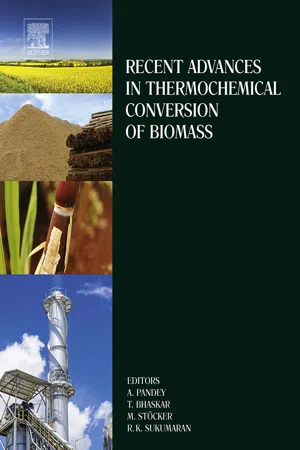
Recent Advances in Thermochemical Conversion of Biomass
- 504 pages
- English
- ePUB (mobile friendly)
- Available on iOS & Android
Recent Advances in Thermochemical Conversion of Biomass
About This Book
This book provides general information and data on one of the most promising renewable energy sources: biomass for its thermochemical conversion. During the last few years, there has been increasing focus on developing the processes and technologies for the conversion of biomass to liquid and gaseous fuels and chemicals, in particular to develop low-cost technologies.
This book provides date-based scientific information on the most advanced and innovative processing of biomass as well as the process development elements on thermochemical processing of biomass for the production of biofuels and bio-products on (biomass-based biorefinery). The conversion of biomass to biofuels and other value-added products on the principle biorefinery offers potential from technological perspectives as alternate energy.The book covers intensive R&D and technological developments done during the last few years in the area of renewable energy utilizing biomass as feedstock and will be highly beneficial for the researchers, scientists and engineers working in the area of biomass-biofuels- biorefinery.
- Provides the most advanced and innovative thermochemical conversion technology for biomass
- Provides information on large scales such as thermochemical biorefinery
- Useful for researchers intending to study scale up
- Serves as both a textbook for graduate students and a reference book for researchers
- Provides information on integration of process and technology on thermochemical conversion of biomass
Frequently asked questions
Information
Advances in Thermochemical Conversion of Biomass—Introduction
b CSIR—National Institute for Interdisciplinary Science and Technology, Trivandrum, India
* Corresponding author: [email protected]
Abstract
1.1 World Energy Demand and Supply/Preamble
Table of contents
- Cover image
- Title page
- Table of Contents
- Copyright
- Contributors
- Preface
- I: General
- II: Primary Processes
- III: Secondary Processes
- Index